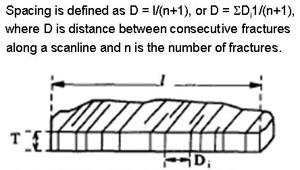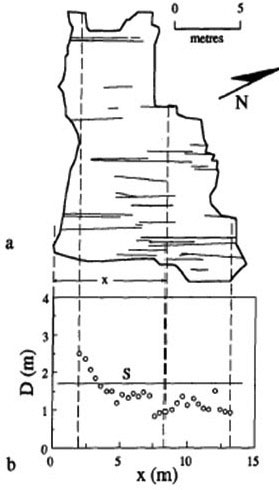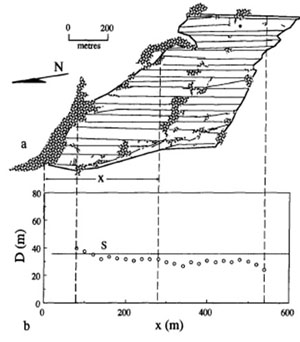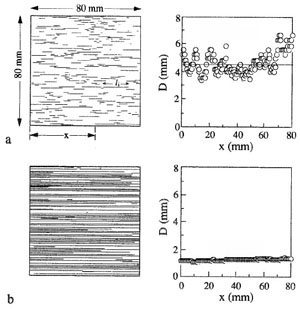| |||||||||
|
|
|||||||||
|
|
|||||||||
| Joint Spacing | |||||||||
|
Joint spacing and its inverse, joint density, are important characteristics of joint arrays relevant to most properties of jointed rock masses, including strength, elastic moduli, and hydraulic properties. Aside from widespread applications in stability of engineering structures, flow of ground water, oil and gas exploration and production, and CO2 sequestration, joint spacing characteristics also reveal how rock fractures develop in nature and in laboratory experiments. There have been a large number of studies of joint spacing in the field, in laboratory experiments, and in theoretical models. Before launching into these topics, let us first review common terms and definitions related to spacing. Spacing of joints is the distance between two adjacent joints, usually defined as the average or mean value of spacings along a scanline across a joint set. Sometimes the number or length of joints within a prescribed area is used to quantify the distribution of joints. The measurement of joint spacing is discussed in the section 'Measurement of Joint Spacing.' Here, we provide the basic definitions as expressed and illustrated in Figure 1. Figure 2 and Figure 3 show joint spacing data from sedimentary rocks cropping out in two different locations: 2 (a and b) show a poorly developed joint set and consequently, uneven joint spacing along 28 scanlines, and 3 (a and b) show highly uniform joint spacing measured from a well-developed joint set using a comparable number of scanlines. During the development of a joint set, the spacing attains a constant value at a certain strain magnitude, and this stage is referred to as the fracture saturation state. It should be noted that the joint spacing at this state marks the end of the addition of new joints into the system and consequently is significant.
It is easier to test these concepts in the laboratory using well-known materials under controlled conditions. Figure 4 shows the results of a pair of experiments (Wu and Pollard, 1995) which produced a poorly-developed joint set with a wide range of spacing along various scanlines (a on top row) and a well-developed joint set or a saturated state with a narrow range of spacing (b on bottom row). There are many factors affecting joint spacing, such as magnitude of strain, strain rate, rock physical properties, temporal evolution, and layer thickness in layered rocks. These are analyzed in various sub-sections under 'Joints.' | |||||||||
| Types of Joint Spacing: | |||||||||
| Joint Spacing Distribution Columnar Joint Spacing Joint Spacing - Layer Thickness ScalingJoint Spacing Affected by Rock Subcritical IndexJoint Spacing Affected by Strain | |||||||||
| Reference: |
|||||||||
| Bai, T., Pollard, D.D., 1999 Narr, W., Suppe, J., 1991 Price, N.J., Cosgrove, J.W., 1990 Wu, H., 1993 Wu, H., Pollard, D.D., 1995 |
|||||||||
|
Readme | About Us | Acknowledgement | How to Cite | Terms of Use | Ⓒ Rock Fracture Knowledgebase |
|||||||||



